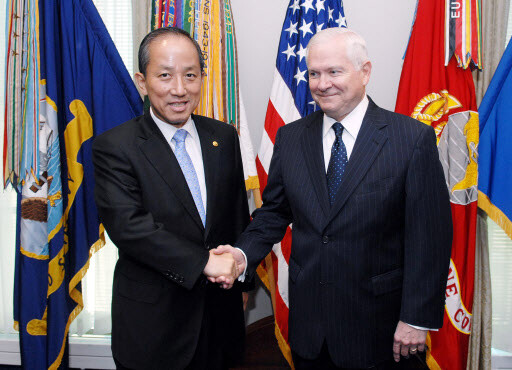hankyoreh
Links to other country sites 다른 나라 사이트 링크
S. Korea - U.S. to organize a joint committee for extending nuclear deterrence

By Kwon Hyuk-chul, Staff writer
South Korea and the United States held their 42nd Security Consultative Meeting (SCM) on Friday (local time) in Washington, D.C., where they agreed to form an extended deterrence policy committee with participation from the defense ministries of both countries in order to institutionalize U.S. cooperation for providing extended deterrence.
In military strategic terms, “extended deterrence” specifies the “nuclear umbrella” in which the U.S. would retaliate with nuclear weaponry when one of its allies is subjected to a nuclear attack. Following their meeting Friday, South Korean Defense Minister Kim Tae-young and U.S. Secretary of Defense Robert Gates released a joint statement that includes institutionalizing the extended deterrence policy committee.
A Defense Ministry Official said that this committee “increases the sharing of extended deterrence-related information and periodically examines and evaluates the effectiveness of extended deterrence.”
“Through South Korea-U.S. discussions, it formulates policy alternatives for deterring North Korean provocations and preparing for the possible threat of nuclear weapons and weapons of mass destruction,” the official added.
While the committee will primarily focus on discussing the provision of the U.S. nuclear umbrella, it may also engage in discussions on providing extended deterrence-related conventional forces when needed.
“To date, South Korea and the U.S. have engaged in discussions sporadically when a situation has arisen, such as a North Korean nuclear test, but in the future a permanent binational cooperative body will be periodically evaluating the situation and establishing measures, formulating concrete plans to enhance the effectiveness of extended deterrence,” the official said.
The two countries plan to hold regular extended deterrence committee meetings beginning next year, chaired jointly by bureau director-level officials from their respective defense ministries.
South Korea and the U.S. first stated the concept of extended deterrence in the joint statement from the 38th SCM in October 2006 following North Korea's first nuclear test. After the South Korean government asked that the concept be fleshed out further, the U.S. stipulated the provision of three means of extended deterrence—the nuclear umbrella, conventional strike capability, and missile defense (MD)—in the joint statement for the 41st SCM held in October 2009.
The newly created committee will engage in discussions on what shape the means of extended deterrence are to take.
The two countries’ defense ministers also reached an agreement on “Strategic Alliance 2015,” a plan to revert wartime operational command to South Korea, which has been postponed until 2015.
“Strategic Alliance 2015” includes necessary military measures for implementing the reversion. These measures include the development of operational plans and the necessary abilities and systems for a combined defense posture, as well as plans for pursuing the repositioning of U.S. Forces in Korea and the adjustment of responsibility for managing the Korean War armistice.
The defense ministers also agreed to and signed “national defense guidelines,” which include content regarding the mid- and long-term direction of military cooperation, and “strategy planning guidelines,” defense ministry-level guidelines for formulating new operational plans to replace the current Operations Plan 5027.
Gates said at a joint news conference after SCM that he expected the youngest son of North Korean leader Kim Jong-il, Kim Jong-un, to assume power "at some point."
Please direct questions or comments to [englishhani@hani.co.kr].
Editorial・opinion
![[Column] Park Geun-hye déjà vu in Yoon Suk-yeol [Column] Park Geun-hye déjà vu in Yoon Suk-yeol](https://flexible.img.hani.co.kr/flexible/normal/500/300/imgdb/original/2024/0424/651713945113788.jpg) [Column] Park Geun-hye déjà vu in Yoon Suk-yeol
[Column] Park Geun-hye déjà vu in Yoon Suk-yeol![[Editorial] New weight of N. Korea’s nuclear threats makes dialogue all the more urgent [Editorial] New weight of N. Korea’s nuclear threats makes dialogue all the more urgent](https://flexible.img.hani.co.kr/flexible/normal/500/300/imgdb/original/2024/0424/7317139454662664.jpg) [Editorial] New weight of N. Korea’s nuclear threats makes dialogue all the more urgent
[Editorial] New weight of N. Korea’s nuclear threats makes dialogue all the more urgent- [Guest essay] The real reason Korea’s new right wants to dub Rhee a founding father
- [Column] ‘Choson’: Is it time we start referring to N. Korea in its own terms?
- [Editorial] Japan’s rewriting of history with Korea has gone too far
- [Column] The president’s questionable capacity for dialogue
- [Column] Are chaebol firms just pizza pies for families to divvy up as they please?
- [Column] Has Korea, too, crossed the Rubicon on China?
- [Correspondent’s column] In Japan’s alliance with US, echoes of its past alliances with UK
- [Editorial] Does Yoon think the Korean public is wrong?
Most viewed articles
- 1‘We must say no’: Seoul defense chief on Korean, USFK involvement in hypothetical Taiwan crisis
- 2N. Korean delegation’s trip to Iran shows how Pyongyang is leveraging ties with Moscow
- 3‘Weddingflation’ breaks the bank for Korean couples-to-be
- 4Korea sees more deaths than births for 52nd consecutive month in February
- 546% of cases of violence against women in Korea perpetrated by intimate partner, study finds
- 6Will NewJeans end up collateral damage in internal feud at K-pop juggernaut Hybe?
- 7[Column] Park Geun-hye déjà vu in Yoon Suk-yeol
- 8[Editorial] New weight of N. Korea’s nuclear threats makes dialogue all the more urgent
- 9Amnesty notes ‘erosion’ of freedom of expression in Korea in annual human rights report
- 10“Parental care contracts” increasingly common in South Korea